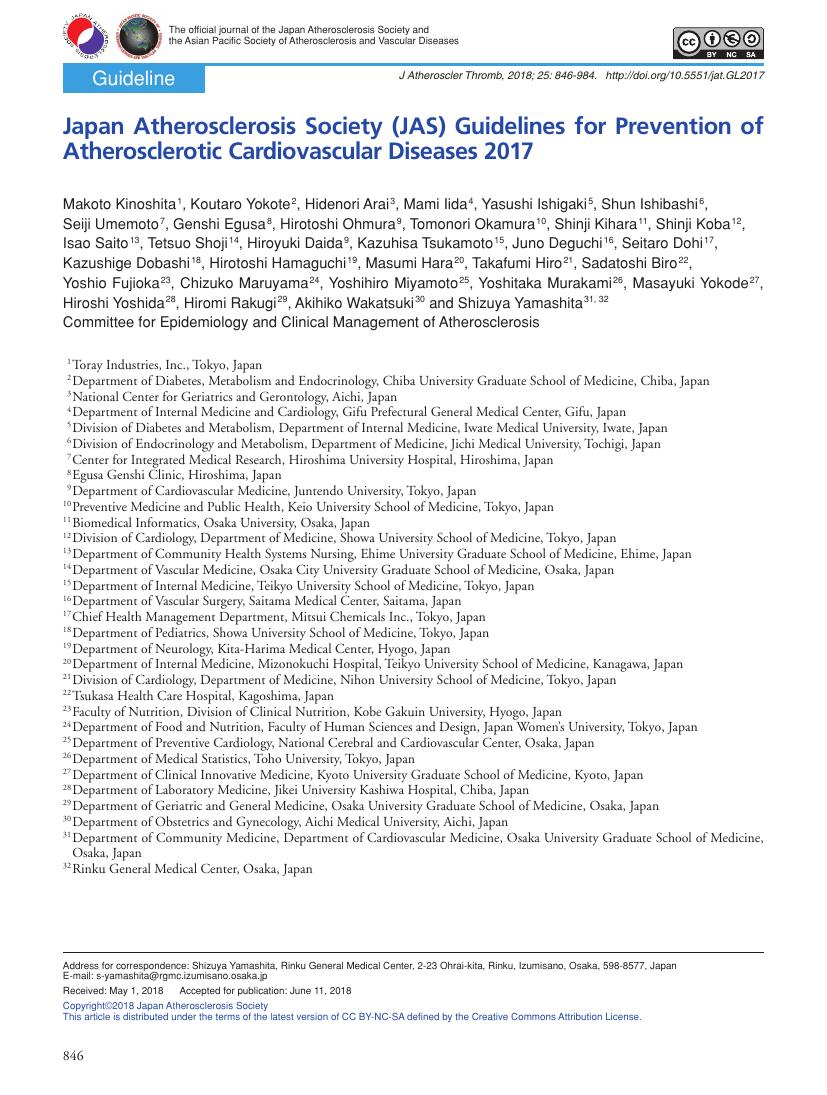- 著者
- Mariko Harada-Shiba Hidenori Arai Yasushi Ishigaki Shun Ishibashi Tomonori Okamura Masatsune Ogura Kazushige Dobashi Atsushi Nohara Hideaki Bujo Katsumi Miyauchi Shizuya Yamashita Koutaro Yokote Working Group by Japan Atherosclerosis Society for Making Guidance of Familial Hypercholesterolemia
- 出版者
- Japan Atherosclerosis Society
- 雑誌
- Journal of Atherosclerosis and Thrombosis (ISSN:13403478)
- 巻号頁・発行日
- pp.CR003, (Released:2018-06-07)
- 参考文献数
- 74
- 被引用文献数
- 166
Statement1. Familial hypercholesterolemia (FH) is an autosomal hereditary disease with the 3 major clinical features of hyper-LDL-cholesterolemia, premature coronary artery disease and tendon and skin xanthomas. As there is a considerably high risk of coronary artery disease, in addition to early diagnosis and intensive treatment, family screening (cascade screening) is required (Recommendation level A)2.For a diagnosis of FH, at least 2 of the following criteria should be satisfied:① LDL-C ≥180 mg/dL, ② Tendon/skin xanthomas, ③ History of FH or premature coronary artery disease (CAD) within 2nd degree blood relatives (Recommendation level A)3. Intensive lipid-lowering therapy is necessary for the treatment of FH. First-line drug should be statin. (Recommendation level A, evidence level 3)4.Screening for coronary artery disease as well as asymptomatic atherosclerosis should be conducted periodically in FH patients. (Recommendation level A)5. For homozygous FH, consider LDL apheresis and treatment with PCSK9 inhibitors or MTP inhibitors. (Recommendation level A)6.For severe forms of heterozygous FH who have resistant to drug therapy, consider PCSK9 inhibitors and LDL apheresis. (Recommendation level A)7.Refer FH homozygotes as well as heterozygotes who are resistant to drug therapy, who are children or are pregnant or have the desire to bear children to a specialist. (Recommendation level A)
- 著者
- Makoto Kinoshita Koutaro Yokote Hidenori Arai Mami Iida Yasushi Ishigaki Shun Ishibashi Seiji Umemoto Genshi Egusa Hirotoshi Ohmura Tomonori Okamura Shinji Kihara Shinji Koba Isao Saito Tetsuo Shoji Hiroyuki Daida Kazuhisa Tsukamoto Juno Deguchi Seitaro Dohi Kazushige Dobashi Hirotoshi Hamaguchi Masumi Hara Takafumi Hiro Sadatoshi Biro Yoshio Fujioka Chizuko Maruyama Yoshihiro Miyamoto Yoshitaka Murakami Masayuki Yokode Hiroshi Yoshida Hiromi Rakugi Akihiko Wakatsuki Shizuya Yamashita Committee for Epidemiology and Clinical Management of Atherosclerosis
- 出版者
- Japan Atherosclerosis Society
- 雑誌
- Journal of Atherosclerosis and Thrombosis (ISSN:13403478)
- 巻号頁・発行日
- vol.25, no.9, pp.846-984, 2018-09-01 (Released:2018-09-01)
- 参考文献数
- 999
- 被引用文献数
- 347 524
- 著者
- Mariko Harada-Shiba Hidenori Arai Shinichi Oikawa Takao Ohta Tomoo Okada Tomonori Okamura Atsushi Nohara Hideaki Bujo Koutaro Yokote Akihiko Wakatsuki Shun Ishibashi Shizuya Yamashita
- 出版者
- Japan Atherosclerosis Society
- 雑誌
- Journal of Atherosclerosis and Thrombosis (ISSN:13403478)
- 巻号頁・発行日
- vol.19, no.12, pp.1043-1060, 2012 (Released:2012-12-20)
- 参考文献数
- 85
- 被引用文献数
- 144 145
Familial hypercholesterolemia (FH) is a highly prevalent autosomal dominant hereditary disease, generally characterized by three major signs, hyper-low-density-lipoprotein (LDL) cholesterolemia, tendon/skin xanthomas and premature coronary artery disease (CAD). Because the risk of CAD is very high in these patients, they should be identified at an early stage of their lives and started on intensive treatment to control LDL-cholesterol. We here introduce a new guideline for the management of FH patients in Japan intending to achieve better control to prevent CAD. Diagnostic criteria for heterozygous FH are 2 or more of 1) LDL-cholesterol ≥180 mg/dL, 2) tendon/skin xanthoma(s), and 3) family history of FH or premature CAD within second degree relatives, for adults; and to have both 1) LDL-cholesterol ≥140 mg/dL and 2) family history of FH or premature CAD within second degree relatives, for children. For the treatment of adult heterozygous FH, intensive lipid control with statins and other drugs is necessary. Other risks of CAD, such as smoking, diabetes mellitus, hypertension etc., should also be controlled strictly. Atherosclerosis in coronary, carotid, or peripheral arteries, the aorta and aortic valve should be screened periodically. FH in children, pregnant women, and women who wish to bear a child should be referred to specialists. For homozygotes and severe heterozygotes resistant to drug therapies, LDL apheresis should be performed. The treatment cost of homozygous FH is authorized to be covered under the program of Research on Measures against Intractable Diseases by the Japanese Ministry of Health, Labour, and Welfare.
1 0 0 0 OA Podocyte-specific Transcription Factors: Could MafB Become a Therapeutic Target for Kidney Disease?
- 著者
- Naoki Morito Toshiaki Usui Shun Ishibashi Kunihiro Yamagata
- 出版者
- The Japanese Society of Internal Medicine
- 雑誌
- Internal Medicine (ISSN:09182918)
- 巻号頁・発行日
- vol.62, no.1, pp.11-19, 2023-01-01 (Released:2023-01-01)
- 参考文献数
- 78
- 被引用文献数
- 2
The increasing number of patients with chronic kidney disease (CKD) is being recognized as an emerging global health problem. Recently, it has become clear that injury and loss of glomerular visceral epithelial cells, known as podocytes, is a common early event in many forms of CKD. Podocytes are highly specialized epithelial cells that cover the outer layer of the glomerular basement membrane. They serve as the final barrier to urinary protein loss through the formation and maintenance of specialized foot-processes and an interposed slit-diaphragm. We previously reported that the transcription factor MafB regulates the podocyte slit diaphragm protein production and transcription factor Tcf21. We showed that the forced expression of MafB was able to prevent CKD. In this review, we discuss recent advances and offer an updated overview of the functions of podocyte-specific transcription factors in kidney biology, aiming to present new perspectives on the progression of CKD and respective therapeutic strategies.
